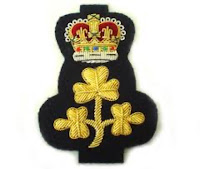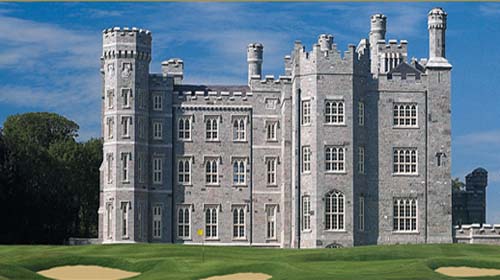The surname of BERESFORD was assumed from Beresford, in the parish of Alstonefield, Staffordshire, of which manor JOHN DE BERESFORD was possessed in 1087, during the reign of WILLIAM II, and was succeeded therein by his son, HUGH DE BERESFORD, from whom lineally descended
JOHN BERESFORD, Lord of Beresford and Enson, who married Elizabeth, daughter of William Basset, of Blore, Staffordshire, and had, with other issue,
JOHN, his heir;Mr Beresford died in 1475, and was succeeded at Beresford by his eldest son; while the second,
THOMAS, of whom hereafter.
THOMAS BERESFORD, seated himself at Newton Grange, Derbyshire, where he was resident in the reigns of HENRY VI and EDWARD IV; the former of whom he served in his French wars, and according to tradition, mustered a troop of horse at Chesterfield, consisting alone of his sons, and his own and their attendants.
Mr Beresford wedded Agnes, daughter and heiress of Robert Hassal, of Arclid, Cheshire, by whom he had sixteen sons and five daughters, and was succeeded by his eldest son, Aden; but we pass to the seventh,
HUMPHREY BERESFORD, who eventually became of Newton Grange.
This gentleman espoused Margery, daughter of Edmond Berdesey, or Beresley, and was succeeded by his second son (the eldest having left a daughter only at his decease),
GEORGE BERESFORD, whose eldest son,
MICHAEL BERESFORD, was an officer in the Court of Wards, and was seated at Oxford, and The Squerries, in Kent.
Mr Beresford, who was living in 1574, married Rose, daughter of John Knevitt, and had seven sons and four daughters; of whom
TRISTRAM BERESFORD (c1574-1666), the third son,
Going into Ulster in the reign of JAMES I, as manager of the Corporation of London, known by the name of the Society of the New Plantation in Ulster, settled at Coleraine, County Londonderry, and was succeeded by his elder son,SIR TRISTRAM BERESFORD (1595-1673), who was created a baronet in 1665, designated of Coleraine, County Londonderry.
He married firstly, Anne, eldest daughter of John Rowley, of Castleroe, County Londonderry, by whom he had one son, RANDAL, his heir, and two daughters; and secondly, Sarah Sackville, and had three sons and three daughters, viz.
Tristram;Sir Tristram was succeeded by his eldest son,
Michael;
Sackville;
Susanna; Sarah; Anne.
SIR RANDAL BERESFORD, 2nd Baronet (c1636-81), MP for Coleraine, 1661-68, who married Catherine, younger daughter of Francis, Viscount Valentia, and niece, maternally, of Philip, 1st Earl of Chesterfield; and dying in 1681, left issue,
TRISTRAM, his heir;Sir Randal was succeeded by his eldest surviving son,
Jane; Catherine.
SIR TRISTRAM BERESFORD, 3rd Baronet (1669-1701), MP for Londonderry County, 1692-99, who commanded a foot regiment against JAMES II, and was attainted by the parliament of that monarch.
Sir Tristram wedded, in 1687, Nichola Sophia, youngest daughter and co-heiress of Hugh Hamilton, 1st Viscount Glenawly, and had issue,
MARCUS, his heir;He was succeeded by his son,
Susanna Catherina; Arabella Maria; Jane; Aramintha.
SIR MARCUS BERESFORD, 4th Baronet (1694-1763), MP for Coleraine, 1715-20, who espoused, in 1717, Catherine, BARONESS LE POER, daughter and heiress of James, 3rd Earl of Tyrone, and in consequence of that alliance, was elevated to the peerage, in 1720, in the dignity of Baron Beresford and Viscount Tyrone.
His lordship was further advanced to an earldom, in 1746, as EARL OF TYRONE.
He had surviving issue,
GEORGE DE LA POER, his successor;His lordship was succeeded by his eldest son,
John;
William (Most Rev), created BARON DECIES;
Anne; Jane; Catherine; Aramintha; Frances Maria; Elizabeth.
GEORGE, 2nd Earl (1735-1800), KP, who married, in 1769, Elizabeth, only daughter and heiress of Henry Monck, of Charleville, and the Lady Isabella Bentinck, daughter of Henry, 1st Duke of Portland, and had issue,
GEORGE DE LA POER, his successor;He inherited the ancient Barony of de la Poer at the decease of his mother in 1769.
John George (Most Rev), Lord Archbishop of Armagh;
George Thomas (Rt Hon), Lt-Gen, GCH;
Isabella Anne; Catherine; Anne; Elizabeth Louisa.
 |
| George, 1st Marquess of Waterford KP |
His lordship was enrolled amongst the peers of Great Britain, in 1786, as Baron Tyrone; and created, in 1789, MARQUESS OF WATERFORD.
He was succeeded by his eldest son,
HENRY, 2nd Marquess (1772-1826), who wedded, in 1805, Susanna, only daughter and heiress of George, 2nd Earl of Tyrconnell, and had issue,
HENRY, his successor;His lordship, who was a Knight of St Patrick, a Privy Counsellor in Ireland, Governor of County Waterford, and Colonel of the Waterford Militia, was succeeded by his eldest son,
William;
John;
James;
Sarah Elizabeth.
HENRY, 3rd Marquess.
- Henry de La Poer Beresford, 3rd Marquess (1811–59)
- John de La Poer Beresford, 4th Marquess (1814–66)
- Henry de La Poer Beresford, 6th Marquess (1875–1911)
The heir apparent is the present holder's son, Richard John de la Poer Beresford, styled Earl of Tyrone, a polo professional who is known as Richard Le Poer.
- John Hubert de La Poer Beresford, 8th Marquess (1933–2015)
*****
The Waterfords were a Patrick family, four members of whom were Knights of the Most Illustrious Order of St Patrick.
CURRAGHMORE, near Portlaw, County Waterford, is the ancestral seat of the 9th and present Marquess of Waterford.
Some 2,500 acres of formal gardens, woodland and grazing fields make this one of the largest private demesnes in Ireland and one of the finest places to visit.
A Sitka Spruce planted on the estate in the 1830s is among the tallest tree in Ireland and stands guard over King John's Bridge.
Built in 1205, this stone-arched structure, spanning the Clodagh River, is the oldest bridge in Ireland.
Twelve miles of famine relief boundary wall and four sturdy wrought iron gates surround the estate.
Gnarled pink chestnut trees line the approach to the big house and original castle tower.
St Hubert's stag with crucifix between its antlers - genuine horns on the de la Poer family emblem - gazes across the large Courtyard from atop the old castle.
Today, the formal gardens surrounding Curraghmore House are open for the public to visit on Thursday afternoons from 2pm to 5pm between Easter and mid-October.
Group tours of the main reception rooms of Curraghmore House can be arranged by prior appointment.
This tour takes in some of the finest Neo-Classical rooms in Ireland which feature the magnificent plaster work of James Wyatt and grisaille panels by Peter de Gree.
Curraghmore, near Portlaw, meaning great bog, is the last of four castles built by the de la Poer family after their arrival in Ireland in 1167.
The Castle walls are about 12 feet thick and within one, a tight spiral stairway connects the lower ground floor with the roof above.
Of the many curious and interesting features of Curraghmore, the most striking is the courtyard front of the house, where the original castle is encased in a spectacular Victorian mansion with flanking Georgian ranges.
The combination of architectural features from several periods around the ancient core of the original castle produces a most striking composition; "immediately recognizable and undeniably moving", as it was described by Country Life magazine.
In more than 800 years the property has passed through the female line only once, and that was prior to Catherine de la Poer marrying Sir Marcus Beresford Bt in 1715, when she was a mere teenager.
Together with her husband, it was she who carried out much of the remodelling of the house and grounds and it was Catherine, Lady Beresford, who created the unique Shell-house herself.
The quality of the craftsmanship employed on the developments on Curraghmore through the ages, has secured the House's reputation as one of the most important country houses in Ireland.
In the late 18th century, the 2nd Earl, afterwards 1st Marquess of Waterford, secured the famous architect James Wyatt to design the next phase of modernisation of Curraghmore.
Here he created a series of rooms, with decoration considered by many to be among his most successful.
After Wyatt's Georgian developments, work at Curraghmore in the 19th century concentrated on the gardens and the Victorian refacing to the front of the house.
Formal parterre, tiered lawns, lake, arboretum and kitchen gardens were all developed during this time and survive to today.
At this time some of Ireland's most remarkable surviving trees were planted in the estate's arboretum.
Today these trees frame miles of beautiful river walks.
Developments in the gardens are still under-way and a Japanese garden has been laid out by the present Lady Waterford.
The present day Beresfords are country people by tradition.
Farming, hunting, breeding hounds and horses and an active social calendar continues as it did centuries ago.
Weekly game-shooting parties are held every season (November through to January); and in spring, calves, foals and lambs can be seen in abundance on Curraghmore's verdant fields.
Polo is still played on the estate in summer.
Throughout Ireland's turbulent history, this family have never been 'absentee landlords' and they still provide diverse employment for a number of local people.
Change comes slowly to Curraghmore - table linen, cutlery and dishes from the early 19th century are still in use.
Other former seat ~ Ford Castle, Northumberland.
I am grateful to Lord Waterford for the information provided from Curraghmore's website.
First published in July, 2011. Waterford arms courtesy of European Heraldry.
























